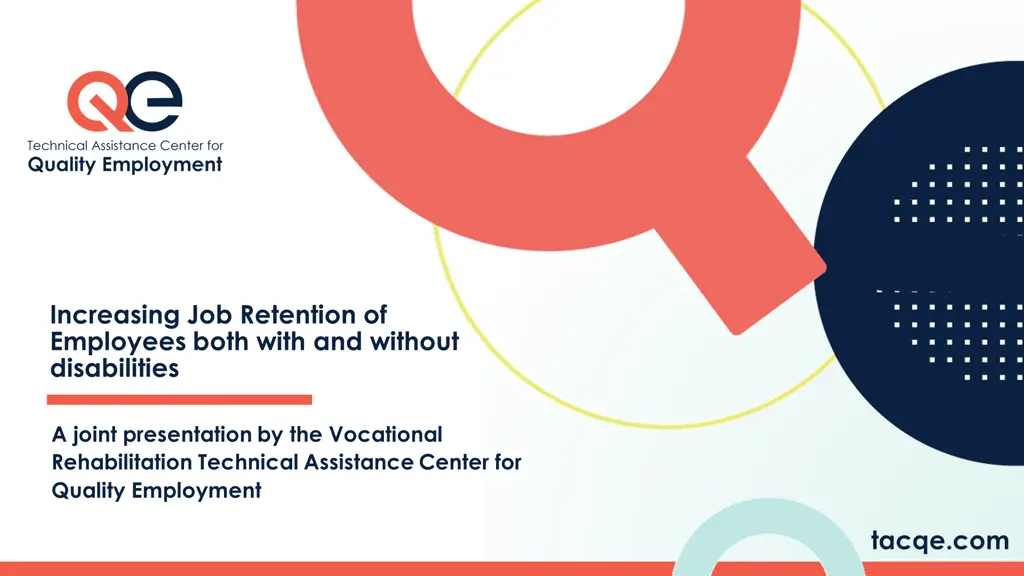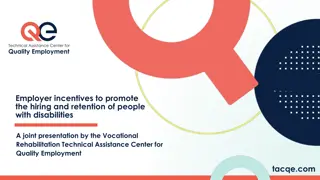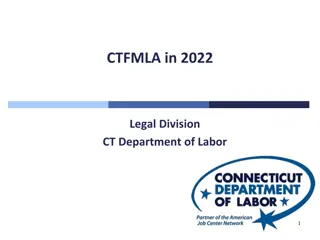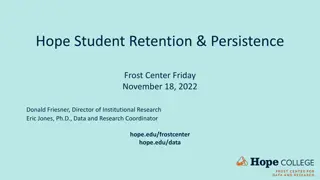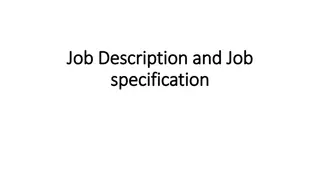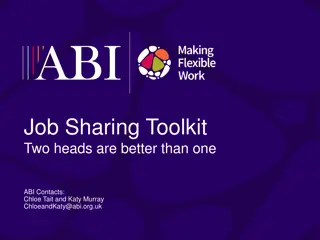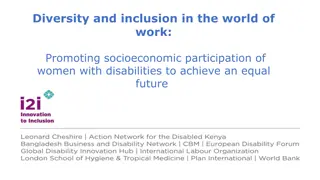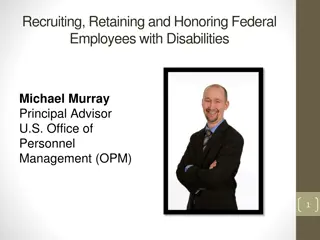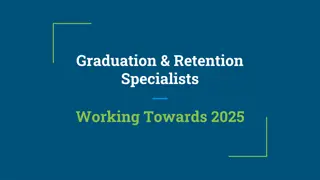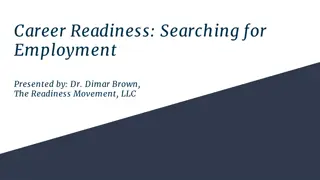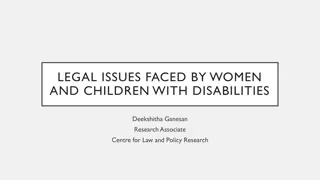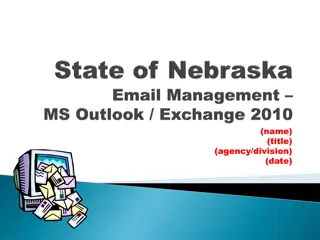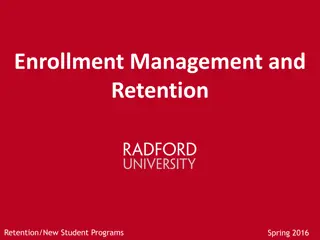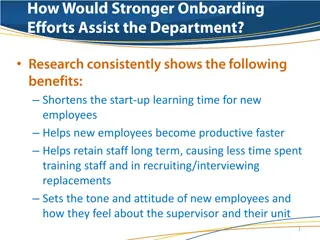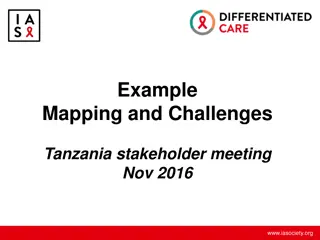Increasing Job Retention of Employees both with and without disabilities
A joint presentation by the Vocational Rehabilitation Technical Assistance Center for Quality Employment on strategies to increase job retention for employees with and without disabilities.
Download Presentation

Please find below an Image/Link to download the presentation.
The content on the website is provided AS IS for your information and personal use only. It may not be sold, licensed, or shared on other websites without obtaining consent from the author. Download presentation by click this link. If you encounter any issues during the download, it is possible that the publisher has removed the file from their server.
E N D
Presentation Transcript
Increasing Job Retention of Employees both with and without disabilities A joint presentation by the Vocational Rehabilitation Technical Assistance Center for Quality Employment tacqe.com
Presented by Emily Brinck Researcher- VRTAC-QE University of Wisconsin-Madison Deborah Lee Researcher- VRTAC-QE University of Wisconsin-Madison tacqe.com
Vocational Rehabilitation Technical Assistance Center for Quality Employment Goal: The Technical Assistance Center for Quality Employment will increase the number and quality of employment outcomes for individuals with disabilities through training and technical assistance to State VR agency personnel. The VRTAC-QE will support State VR agency personnel to implement innovative and effective employment strategies and supporting practices. tacqe.com
Acknowledgement & Disclaimer: The contents of this presentation were developed under a grant, the Vocational Rehabilitation Technical Assistance Center for Quality Employment, H264K200003, from the U.S. Department of Education. However, those contents do not necessarily represent the policy of the U.S. Department of Education, and you should not assume endorsement by the Federal government.
Presentation Overview Reasons for Job Retention Universal design principles Workplace modification and accommodation Natural support and culture of the workplace Diversity management
Questions Why do workers decide to quit their jobs? If a worker isn t quitting to go to a different job (e.g., choosing unemployment), do his/her reasons for leaving differ from those workers who leave for a different job? If so, in what way? What are some strategies that you have put into place to retain employees?
Job retention Onboarding and training Onboarding issues are primarily rooted in unrealistic job portrayals during the interview stage When it comes to training, simply offering opportunities and investing in the development of your staff puts you ahead of the game Flexibility As it relates to work schedules, making appointments, or life events Identify areas where it is possible to be flexible and maximize those efforts Financial considerations Compensation influences retention, but usually in combination with employee perceptions of onboarding/training and flexibility More money alone helps retain workers, but greatest effect is when employees feel employers are willing to work with them
Job retention (cont.) Work-life balance Checking in with employees regarding this balance can at least help employees feel like their employer cares about them Consider options related to flexibility to assist employees in managing their life situation Effective managers Poor management can disrupt or limit productivity in the workplace Managers need to manage rather than micromanage Recognition Poor management combined with lack of recognition results in high turn over Identify ways to recognize employees either internally (opportunities for advancement) or externally (i.e., social media, recognition focused apps)
Increasing Employee Retention Promote a positive workplace environment Acknowledge high quality or high commitment to work Provide benefits for workers Ongoing training to keep skills fresh and increase opportunities for advancement
Universal Design in the Workplace What is Universal Design? Creating environments, products and services that meet a wide range of preferences and needs Avoiding future needs for adaptation, renovation, and specialized design
Universal Design in the Workplace For Employees Develop the workplace environment to address the needs of a diverse group of employees, including people with disabilities. Recognize that each employee, or prospective employee, possesses a unique set of abilities and limitations. By approaching the workplace with Universal Design principles, businesses can optimize productivity, safety, collaboration and communication for all employees
Workplace modification Workplace modification and accommodation can increase: job satisfaction overall productivity retention of employees enhanced interactions between coworkers elevate overall company morale increased attendance eliminated cost of hiring new employees
Workplace integration Developing company-appropriate strategies for the request of workplace modification and accommodations can: Aid in employer-employee communications Normalize the seeking out necessary workplace modification and accommodation as a part of the workplace community Help retain employees that incur a disability while employed by making the request of accommodations a normal part of company life Integrating efforts can also be achieved by: Simple modifications of the workplace setting such as where employees perform job duties Structuring the workplace to facilitate contact between employees with and without disabilities. For example: Have employees with disabilities take breaks at the same time as employees without disabilities Move an employee with a disability s workstation to a higher traffic area to increase contact with coworkers and lead to the development of natural supports
Natural Supports Natural supports involves creating an environment where individuals feel valued, supported, and important. Natural supports for persons with disabilities generally developing on- the-job networks with co-workers Once networks are established, they can provide: education and learning opportunities job showing and job training Mentoring toward mastery of job tasks relationship supports from co-workers
Diversity management Culture and social attitudes playing a central role in persons with disabilities acclimatization to and retention of employment Increasing workplace integration and retention follows three guiding principles: Recognize the importance of harnessing diversity, especially disability as a form of diversity Encourage opportunities for individuals across job functions and workplace hierarchy (i.e., team leader, supervisor, manager, executive) Build internal human resource capabilities to identify individual assets and integrating those workers into those roles they demonstrate unique talents Establish workplace policies regarding worker rights and discrimination reporting that all employees can employ Assess the workplace culture and seek out supports from organizations to increase diversity awareness and acceptance
Thank you! Presenters VRTAC-QE www.tacqe.com contact@tacqe.com tacqe.com
